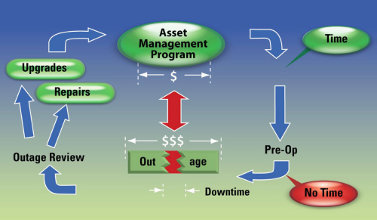Background
Stations continue to be challenged by equipment problems with overhead crane-related evolutions that have resulted in work schedule delays and an increased risk of damage to the loads and nearby equipment and worker injury. In several cases, equipment problems are caused by insufficient preventive maintenance or inspections prior to lifting activities. Reliable and proper overhead crane performance is important to ensure personnel safety, nuclear safety, and the protection of important assets such as the reactor vessel internals, the reactor pressure vessel (RPV) head, fuel assemblies, and dry fuel storage casks.1
Asset management is a strategic approach to balancing equipment performance over the entire expected life of the crane while reducing training and maintenance budgets and spare parts inventory carrying costs. In opposition to run-to-failure mode, this approach consists of predicting and budgeting for periodic upgrades, modernizations, and replacement of obsolete and worn parts.
The push for ever-shorter outage times drives the need for predictability on equipment uptime, particularly for equipment whose performance directly affects the outage critical path schedule.
Description
An asset management program typically has three key phases. The first phase is a review of the current status of the equipment.
- Configuration and condition
- Maintenance history
- Problems with worn or obsolete parts on the machine
- Status of spare parts
This review will entail an equipment walk down and a validation of current prints and procedures, a review of open and closed maintenance work orders, and any past outage field reports that the original equipment manufacturer (OEM) or other vendor may have provided.
Procedures should be reviewed for compliance with current safety and performance objectives. Over time, the functionality of the equipment may have grown beyond the original design specifications, and maintenance procedures may not provide the appropriate level of care.
Spare part inventories should also be reviewed and their “actual” condition evaluated. Spare parts and subassemblies may be classified as critical, non-critical or run-to-failure, with a particular focus on overall system single points of vulnerability.
The second phase of an asset management program consists of implementing the recommendations from phase one. Given budget limitations, a substantial amount of effort needs to be given to prioritizing each element of the phase one recommendations in line with resources and schedules. An Equipment Health Matrix showing each piece of equipment listed in the program visually indicating its condition, e.g., mechanical, electrical, software, maintenance, etc., can be extremely useful.
The third and final phase is critical to maximizing the benefits of an asset management program. It is not only the long-term re-evaluation for continuous improvement, but it is also where Westinghouse, through its subsidiary PaR Nuclear, Inc., has the opportunity to share risk and reward, delivering equipment predictability and uptime, while the operator enjoys the benefits of strategic foresight.


